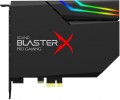Channels
The most advanced multi-channel audio format that a sound card is capable of outputting.
—
2. Standard stereo sound on two channels — left and right. This format allows you to provide a sense of surround sound (especially when using headphones), which is quite enough for most simple tasks. However, it noticeably loses to multi-channel sound in terms of the "immersion effect", which can be critical for demanding gamers and audiophiles.
—
5.1. The classic and most popular multi-channel surround sound format today: a centre channel, two front and two rear channels allow you to achieve a full-fledged “surround effect”, and a separate subwoofer channel provides rich bass sound.
—
7.1. The 7.1 format differs from 5.1 by the presence of two additional channels. There are several options for localizing these channels — for example, a pair of side speakers, a pair of additional speakers above the front ones, etc. Anyway, the 7.1 format provides a more reliable surround sound transmission than 5.1, but such cards are more expensive, and there is less specialized content for 7.1.
When choosing a sound card by the number of channels, it is worth considering such moments. Firstly, multi-channel options are capable of producing sound in simpler formats (for example, a 7.1 card can be used for 5.1 acoustics), and stereo sound output is support
...ed by all models in general. Secondly, modern multimedia software (in particular, codecs) allows you to output multi-channel audio through a card with fewer channels — for example, play 5.1 sound through a two-channel card with stereo speakers without quality loss. Thirdly, for the full-fledged operation of multi-channel sound, you will need not only a card, but also appropriate acoustics; therefore, it makes no sense to specifically look for a multi-channel model if you plan to use exclusively stereo speakers.Audiochip
Brand of the audio chip installed in the sound card.
The audio chip is one of the most important parts of a sound card, a kind of "heart" of the whole circuit, and it is on its characteristics that the sound quality and other capabilities of a particular model largely depend. Knowing the brand of the chip, you can easily find various information on it — official specifications, test results, reviews, etc. — and based on this, draw a conclusion to what extent this sound card is able to meet your requirements. Of course, for ordinary video cards (see "View") there is no need to delve into such details, but when choosing a gaming or audiophile model, they can be very useful.
Standards
Various standards and special digital audio technologies that the sound card is officially compatible with. For example, the Dolby and DTS standards in various variations are used primarily for multi-channel audio tracks in films, while DirectSound and EAX provide high-quality “surround” sound in games. In fact, the ability to work with one or another standard is largely determined by the software part of the system, and not by the characteristics of the sound card; however, official compatibility means at least the full compliance of the card with the requirements of the standard and the minimum risk of conflicts at the hardware level.
ASIO
Sound card compatible with ASIO standard.
ASIO (an abbreviation for Audio Stream Input/Output, i.e. “audio stream input-output”) is a technology designed for professional work with sound in the Windows environment; in particular, it reduces latency and improves the accuracy of the audio stream. If you do not plan to seriously engage in recording, mixing tracks, etc., most likely you will not need this function, but for musicians, sound engineers and other similar professionals, it can be very useful. The ASIO standard provides both software and hardware requirements; therefore, to fully use it, you must have a compatible audio card.
ADC resolution
The bit depth of the analogue-to-digital converter (ADC) of the sound card. An ADC is a module that encodes an analogue audio signal into a digital format; it is he who is responsible for transmitting sound "to the computer" — for example, through a microphone when communicating via Skype or from a guitar pickup when recording a track. The bit depth is one of the main parameters that describe the quality of the ADC: the higher it is, the less distortion will be introduced into the digitized sound and the higher the maximum possible quality of its recording. Of course, the properties of the actually recorded sound will depend on many other things (hardware, software, settings, file format, etc.), but for high-quality recording, you will definitely need a good ADC.
A bit depth of
16 bits is considered quite sufficient for everyday use, however, even fairly simple models of audio cards are increasingly acquiring
24-bit ADCs.
Max. sampling rate
The highest sampling rate that the analogue-to-digital converter (ADC) of a sound card can provide when digitizing sound. Without going into details, we can say that the role of this parameter is almost completely similar to the bit depth described in the paragraph above. And its standard values, found in modern audio cards, correspond to the following sound quality indicators:
44.1 kHz — Audio CD;
48 kHz — DVD
96 kHz — DVD-Audio 5.1
192 kHz — DVD-Audio 2.0 (two-channel audio has a higher sampling rate than multi-channel audio for a number of reasons), the highest value in modern consumer-grade sound cards.

